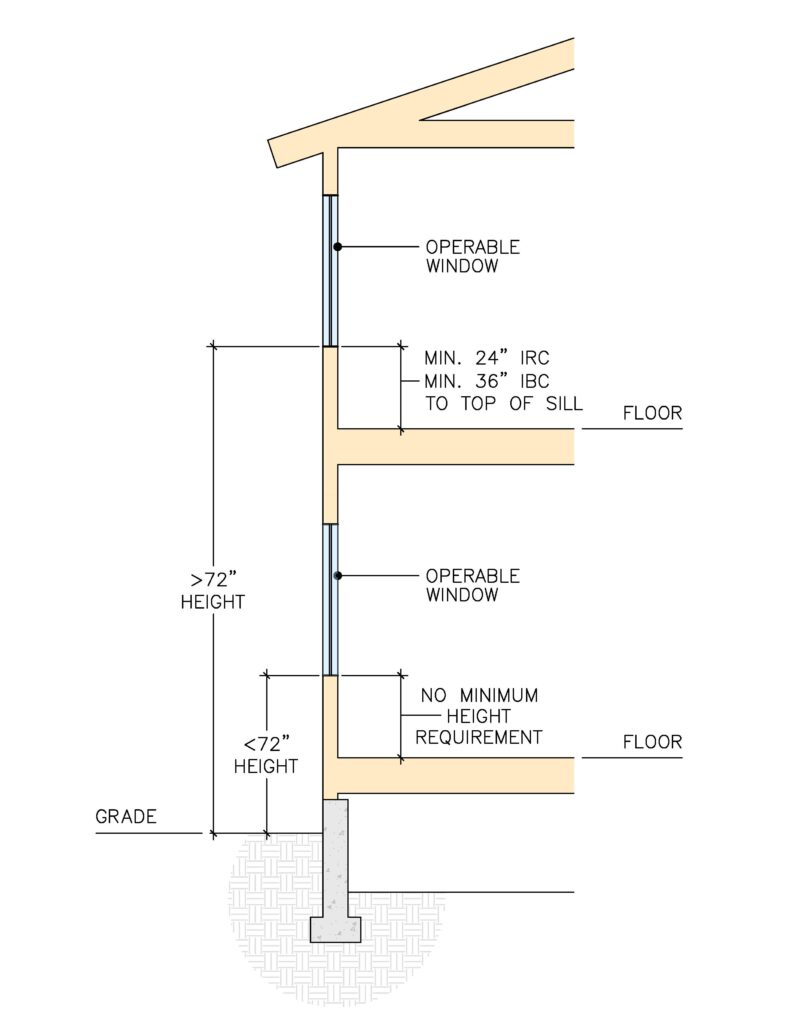When it comes to windows located throughout your home, you might be somewhat familiar with the maximum sill height dimensions required for egress windows, but did you know there is also a minimum dimension applied to sill heights?
Similar to egress windows, the minimum sill height is not required for all windows but for windows that meet certain conditions that would require fall protection.
Section R312.2 of the 2018 International Residential Code outlines the minimum requirements for window fall protection and when it is required. Let’s take a look at when it is necessary to comply with this section and how you can achieve compliance.
Why is Window Fall Protection Required?
The intent of this section is to provide a level of safety or prevention measure that will protect small children from falling out of an open window. When windows get placed in a position that is too high off the ground, protection measures, such as window opening control devices, are looked at as a way of providing a level of safety given the scenario.
When is Window Fall Protection Required?
Per Section R312.2.1 of the 2018 International Residential Code (IRC), all 3 conditions must exist for window fall protection to be required. These conditions are the following:
- The window is operable.
- The top of the sill height is located less than 24 inches above the finished floor.
- The top of the sill height is located more than 72 inches above the finished grade below on the exterior side.
To best visualize this, take a look at the illustration below.

It is important to note however before we move on that per the International Residential Code (IRC), the minimum sill height is 24 inches but per the International Building Code (IBC), the minimum sill height is 36 inch.
Fun Tip: To learn the difference between the International Residential Code (IRC) verses the International Building Code (IBC), be sure to check out this POST.
When all 3 of these conditions apply to your window, fall protection must be required. However, for example if the window is operable, the grade on the exterior is greater than 72 inches in height, but the sill height is 40 inches in height at the interior, then no prevention is necessary since the interior sill height is not less than 24 inches.
How do you Provide Window Fall Protection?
In order to comply with this section, the operable window must meet at least one of the following criteria’s:
- The window opening shall be limited to not allow the passage of a 4 inch diameter sphere to pass through.
- The window is provided with a fall prevention device that complies with ASTM F2090.
- The window is provided with a window opening control device that complies with Section R312.2.2.
To understand option number 3, we must look at Section R312.2.2 which requires window opening control devices to also comply with ASTM F2090.
The control device should have an emergency release mechanism that allows it to release thus allowing the window to fully open so that it does not reduce the net clear opening area of the window to be less than what is required for egress per Section R310.2.1.
Fun Tip: To learn about Egress Window Requirements per the International Residential Code (IRC), be sure to check out this POST.
Therefore it is important to note that when any type of fall prevention device or opening control device is used, it shall not reduce the required opening size of egress windows when the mechanism is released.
As the last two options are somewhat similar, the first option is more of a permanent solution such as a rail system for example. Again this option will require some creativity if installed at egress windows to make sure the egress opening is maintained while fall protection is being provided for those locations that require it.
Window Fall Protection Standard
In the options noted above, the code requires these protection devices to comply with ASTM F2090. This standard is as know as the Standard Specification for Window Fall Prevention Devices with Emergency Escape (Egress) Release Mechanisms.
The standard requires the fall prevention devices to be such that a 4 inch diameter sphere cannot pass through it. Similar to option 1 above this ensure the device acts as somewhat of a guardrail by not allowing any opening larger than 4 inches.
The standard also requires the device to have an emergency release mechanism that can be operated without a key, tool, or any special knowledge thereby ensuring for a quick release in case of an emergency where the opening is required for escape and rescue situations.
To Learn more about window fall protection requirements, be sure to check out Section R312.2 of the 2018 International Residential Code (IRC).
.
* Reference Source – 2018 International Residential Code – [Buy on Amazon]
